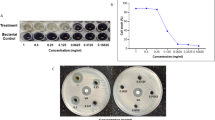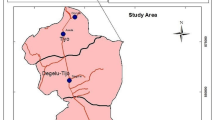Abstract
Effectiveness of saline suspension of Corynebacterium pseudodiphtheriticum containing spray was assessed in a 30-days chamber experiment modeling the effects of hyperthermia and polluted air on humans. Spray was targeted at eliminating Staphylococcus aureus from the nasal cavity of human subjects. Three of four volunteers became S. aureus carriers in the course of the experiment, and one was a chronic carrier of methicillin-resistant S. aureus (MRSA). Spray application eradicated S. aureus in three subjects and reduced its presence in the MRSA carrier. Results of the study suggest that C. pseudodiphtheriticum can be used for control of S. aureus in the nasal environment. However, further investigations are required.



Similar content being viewed by others
References
Lindgren E, Ebi KL, Johannesson M (2010) Climate change and communicable diseases in the EU Member States. Handbook for national vulnerability, impact and adaptation assessments. European Centre for Diseases Prevention and Control
Gasparrini A, Armstrong B (2011) The impact of heat waves on mortality. Epidemiology 22(1):68–73
Anderson GB, Bell ML (2011) Heat waves in the United States: mortality risk during heat waves and effect modification by heat wave characteristics in 43 U.S. communities. Environ Health Perspect 119(2):210–218
D’Ippoliti D, Michelozzi P, Marino C et al (2010) The impact of heat waves on mortality in 9 European cities: results from the EuroHEAT project. Environ Health 9:37
Van De Griend P, Herwaldt LA, Alvis B, DeMartino M, Heilmann K, Doern G, Winokur P, Vonstein DD, Diekema D (2009) Community-associated methicillin-resistant Staphylococcus aureus, Iowa USA. Emerg Infect Dis 15(10):1582–1589
Wiersma P, Tobin D’Angelo M, Daley WR, Tuttle J, Arnold KE, Ray SM, Ladson JL, Bulens SN, Drenzek CL (2009) Surveillance for severe community-associated methicillin-resistant Staphylococcus aureus infection. Epidemiol Infect 137(12):1674–1678
Sdougkos G, Chini V, Papanastasiou DA, Christodoulou G, Stamatakis E, Vris A, Christodoulidi I, Protopapadakis G, Spiliopoulou I (2008) Community-associated Staphylococcus aureus infections and nasal carriage among children: molecular microbial data and clinical characteristics. Clin Microbiol Infect 14(11):995–1001
Dailiana ZH, Rigopoulos N, Varitimidis SE, Poultsides L, Petinaki E, Malizos KN (2008) Clinical and epidemiological features of upper-extremity infections caused by Staphylococcus aureus carrying the PVL gene: a four-year study in Greece. Med Sci Monit 14(10):511–514
Taplin D, Zaias N, Rebell G (1965) Environmental influences on microbiology of the skin. Arch Environ Health 11:546–550
Ilyin VK, Volozhin AI, Vikha GV (2005) Colonization resistance of organism in changed environments. Nauka, Moscow
Il’in VK, Kriukov AI, Volozhin AI, Istranov LP, Istranova EV, Kiriukhina NV, Starkova LV, Morozova IuA, Usanova NA (2008) Investigation of dysbiosis developing during “dry” immersion and methods of correction. Aviakosm Ekolog Med 42(5):70–74
Kriukov AI, Il’in VK, Volozhin AI, Istranov LP, Kiriukhina NV, Starkova LV, Morozova IuA, Usanova NA (2007) Experimental grounds for administration of probiotic drugs in conditions of hydroweightlessness. Vestn Otorinolaringol 4:30–33
Kriukov AI, Il’in VK, Istranov LP, Kiriukhina NV, Morozova IuA (2008) Effect of short-term application of a lactate-containing probiotic on the pharyngeal microbiota in healthy subjects. Vestn Otorinolaringol 5:51–53
von Eiff C, Becker K, Machka K, Stammer H, Peters G (2003) Nasal carriage as a source of Staphylococcus aureus bacteremia. Study group. N Engl J Med 344:11–16
Huang SS, Platt R (2003) Risk of methicillin-resistant Staphylococcus aureus infection after previous infection or colonization. Clin Infect Dis 36:281–285
Wertheim HF, Vos MC, Ott A, van Belkum A, Voss A et al (2004) Risk and outcome of nosocomial Staphylococcus aureus bacteraemia in nasal carriers versus non-carriers. Lancet 364:703–705
Davis KA, Stewart JJ, Crouch HK, Florez CE, Hospenthal DR (2004) Methicillin-resistant Staphylococcus aureus (MRSA) nares colonization at hospital admission and its effect on subsequent MRSA infection. Clin Infect Dis 39:776–782
Datta R, Huang SS (2008) Risk of infection and death due to methicillin-resistant Staphylococcus aureus in long-term carriers. Clin Infect Dis 47:176–181
Wertheim HF, Melles DC, Vos MC et al (2005) The role of nasal carriage in Staphylococcus aureus infections. Lancet Infect Dis 5:751–762
Bradley SF (2011) MRSA colonisation (eradicating colonisation in people without active/invasive infection). Clin Evid 17
McConeghy KW, Mikolich DJ, LaPlante KL (2009) Agents for the decolonization of methicillin-resistant Staphylococcus aureus. Pharmacotherapy 29(3):263–280
van Rijen M, Bonten M, Wenzel R, Kluytmans J (2008) Mupirocin ointment for preventing Staphylococcus aureus infections in nasal carriers. Cochrane Database Syst Rev 8(4):CD006216. doi:10.1002/14651858.CD006216.pub2
Zaloguev SN, Viktorov AN, Zarubina KV, Gorshkov VP (1979) Number of microorganisms released from the upper respiratory tract and the cutaneous integument of persons in a hermetically sealed location. Kosm Biol Aviakosm Med 13(5):61–65
Zaloguev SN, Viktorov AN, Startseva ND (1980) Sanitary-microbiologic and epidemiologic aspects of habitability. Probl Kosm Biol 42:80–140
Patel JB, Gorwitz RJ, Jernigan JA (2009) Mupirocin resistance. Clin Infect Dis 15(49(6)):935–941
Caffrey AR, Quilliam BJ, LaPlante KL (2010) Risk factors associated with mupirocin resistance in methicillin-resistant Staphylococcus aureus. J Hosp Infect 76(3):206–210
McNeil JC, Hulten KG, Kaplan SL, Mason EO (2011) Mupirocin resistance in Staphylococcus aureus causing recurrent skin and soft tissue infections in children. Antimicrob Agents Chemother 55(5):2431–2433
Bathoorn E, Hetem DJ, Alphenaar J, Kusters JG, Bonten MJ (2012) Emergence of high-level mupirocin resistance in coagulase-negative staphylococci associated with increased short-term mupirocin use. J Clin Microbiol 50(9):2947–2950
Doebbeling BN, Reagan DR, Pfaller MA, Houston AK, Hollis RJ, Wenzel RP (1994) Long-term efficacy of intranasal mupirocin ointment. A prospective cohort study of Staphylococcus aureus carriage. Arch Intern Med 154(13):1505–1508
Fernandez C, Gaspar C, Torrellas A, Vindel A, Saez-Nieto JA, Cruzet F, Aguilar L (1995) A double-blind, randomized, placebo-controlled clinical trial to evaluate the safety and efficacy of mupirocin calcium ointment for eliminating nasal carriage of Staphylococcus aureus among hospital personnel. J Antimicrob Chemother 35(3):399–408
Coates T, Bax R, Coates A (2009) Nasal decolonization of Staphylococcus aureus with mupirocin: strengths, weaknesses and future prospects. J Antimicrob Chemother 64(1):9–15
Light IJ, Walton RL, Sutherland JM, Shinefield HR, Brackvogel V (1967) Use of bacterial interference to control a staphylococcal nursery outbreak: deliberate colonization of all infants with the 502A strain of Staphylococcus aureus. Arch Pediatr Adolesc Med 113(3):291–300
Keidel WN (1972) Staphylococcus 502a. Arch Pediatr Adolesc Med 123(6):613
Houck PW, Nelson JD, Kay JL (1972) Fatal septicemia due to Staphylococcus aureus 502A: report of a case and review of the infectious complications of bacterial interference programs. Arch Pediatr Adolesc Med 123(1):45–48
Park B, Iwase T, Liu GY (2011) Intranasal application of S. epidermidis prevents colonization by methicillin-resistant Staphylococcus aureus in mice. PLoS One 6(10):e25880. doi:10.1371/journal.pone.0025880
Iwase T, Uehara Y, Shinji H, Tajima A, Seo H, Takada K, Agata T, Mizunoe Y (2010) Staphylococcus epidermidis Esp inhibits Staphylococcus aureus biofilm formation and nasal colonization. Nature 20(465 (7296)):346–349
Linoli O, Marconi S, Garaffa M (1981) Quantitative bacterial ecology of normal nasal mucosa. Ann Sclavo 23(2):151–161
Lina G, Boutite F, Tristan A, Bes M, Etienne J, Vandenesch F (2003) Bacterial competition for human nasal cavity colonization: role of Staphylococcal agr alleles. Appl Environ Microbiol 69(1):18–23
Lemon KP, Klepac-Ceraj V, Schiffer HK, Brodie EL, Lynch SV, Kolter R (2010) Comparative analyses of the bacterial microbiota of the human nostril and oropharynx. MBio 1(3):e00129–10. doi:10.1128/mBio.00129-10
Kwaszewska A, Szewczyk EM (2007) Production of antibacterial substances by resident corynebacteria isolated from human skin. Med Dosw Mikrobiol 59(3):251–257
Meitert E (1969) On bacteriocins of Corynebacterium diphtheriae. II. Study of the bacteriocins produced by C. diphtheriae, C. ulcerans, C. atypique, C. hoffmani and C. xerose. Arch Roum Pathol Exp Microbiol 28(4):1086–1097
Pátek M, Hochmannová J, Nesvera J, Stránský J (1986) Glutamicin CBII, a bacteriocin-like substance produced by Corynebacterium glutamicum. Antonie Van Leeuwenhoek 52(2):129–140
Uehara Y, Nakama H, Agematsu K, Uchida M, Kawakami Y, Abdul Fattah AS, Maruchi N (2000) Bacterial interference among nasal inhabitants: eradication of Staphylococcus aureus from nasal cavities by artificial implantation of Corynebacterium sp. J Hosp Infect 44(2):127–133
Funke G, von Graevenitz A, Clarridge JE, Bernard KA (1997) Clinical microbiology of coryneform bacteria. Clin Microbiol Rev 10:125–159
Urquhart GED, Gould JC (1965) Simplified technique for counting the number of bacteria in urine and other fluids. J Clin Pathol 18(4):480–482
Glück U, Gebbers JO (2003) Ingested probiotics reduce nasal colonization with pathogenic bacteria (Staphylococcus aureus, Streptococcus pneumoniae, and beta-hemolytic streptococci). Am J Clin Nutr 77(2):517–520
Conflict of interest
The authors declare that they have no conflict of interest
Author information
Authors and Affiliations
Corresponding author
Rights and permissions
About this article
Cite this article
Kiryukhina, N.V., Melnikov, V.G., Suvorov, A.V. et al. Use of Corynebacterium pseudodiphtheriticum for elimination of Staphylococcus aureus from the nasal cavity in volunteers exposed to abnormal microclimate and altered gaseous environment. Probiotics & Antimicro. Prot. 5, 233–238 (2013). https://doi.org/10.1007/s12602-013-9147-x
Published:
Issue Date:
DOI: https://doi.org/10.1007/s12602-013-9147-x




